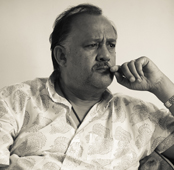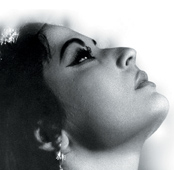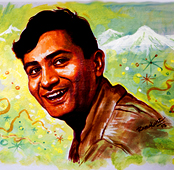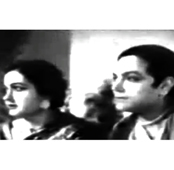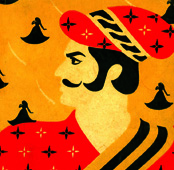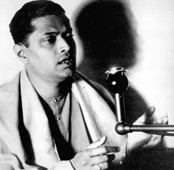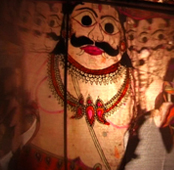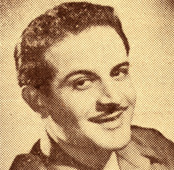-
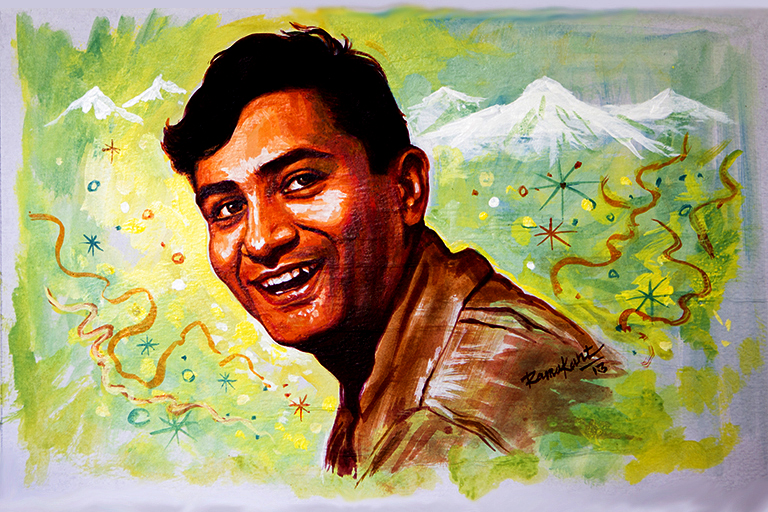 Original artwork for TBIP by poster and portrait artist Ramakant Fadte.
Original artwork for TBIP by poster and portrait artist Ramakant Fadte.
On Dev Anand’s second death anniversary, Sidharth Bhatia writes about India’s longest lasting star who changed cinema forever.
During my interviews with Dev Anand for the book I was writing, the octogenarian star used to often talk about his friendship with Hollywood stars and his love for western cinema. Kirk Douglas, James Stewart, Shirley MacLaine, he had met them all. He admired Charlie Chaplin. He had discussed the possibility of an English film with David O. Selznick, but the latter died suddenly. What he liked about Hollywood was the glamour. Stars, he often said, should be stars. They should have mystique and style and not be seen to be just like everyone else. “Why should stars advertise soap or cement?” he used to say. That larger than life glamour was reflected in his own films and his own persona.
But I think there was more to it than just notions of stardom or the dazzle of Hollywood. He admired the West for its modernity. For Dev Anand was the quintessential modern man, on screen and off. He was an urban and urbane man, from the debonair manner in which he carried himself to the films he made. His films were always set in the city, in an industrial urban landscape, rejecting implicitly the traditional and the conventional. Indian films in the 1930s and 1940s were pegged mostly around mythological, historic or nationalistic themes, often focusing on and glorifying the village. In their manner, mores and technique, the films of Navketan, Dev Anand’s production house, sought out new ideas and values that could have belonged anywhere, not necessarily in the rooted Indian context. For instance, Navketan’s first film Afsar, released in 1950, is a social satire based on Russian dramatist Nikolai Gogol’s The Government Inspector. The second, Baazi (1951), Guru Dutt’s directorial debut, falls squarely in the genre of early Hollywood noir. The city became Navketan’s milieu.
Making urban-centric films in the 1950s was a brave decision. Newly independent India was a predominantly rural nation. Gandhi had said India lives in its villages, which was taken to mean that that is where the country’s policy emphasis should be. The sub-text was also that the village was an idyllic society and the repository of Indian values while the city was alienating, cruel and, most damningly, a Western construct. Rich and exploitative capitalists lived there, who were out to cheat simple and good-hearted villagers.
Raj Kapoor, along with K. A. Abbas, made Shree 420 on that theme and Bimal Roy’s film Do Bigha Zamin brought this out even more starkly. The trope remained with filmmakers for years, well into the 1970s and beyond.
Dev Anand and his brothers, Chetan and Vijay, were not of that mindset. They saw the city, with all its good and evil, for itself. It was the sole protagonist of the Navketan films, which did not resort to using village life as a foil. Elder brother Chetan Anand and Dev had been to Government College, Lahore, an elitist institution which was steeped in Western mores. Chetan’s wife Uma Anand came from a highly Westernized family of Bengali Christians and her father worked in the college; life centred around tea parties and tennis matches. The ICS (Indian Civil Service) was thought to be the natural home for Chetan and he went off to London to prepare; when he did not make it, he joined The Doon School, one of India’s best residential schools, to teach. Young Dev was in the same Westernized, or more specifically, Anglicised mould.
Navketan always remained off the beaten path and Dev Anand and his brothers must take the credit for this. The earlier Bombay Noir black and white films—Baazi, Taxi Driver (1954) etc.—and the later colour films such as Guide (1965), Jewel Thief (1967) and Hare Rama Hare Krishna (1971) were equally bold in their conception and execution. Besides being completely city-centric (Taxi Driver was possibly the first film to be shot completely outdoors in Mumbai), the early Navketan films were unique in that Dev Anand played a kind of anti-hero mostly, with shades of grey to his character. For years afterwards, he continued to play such characters—from House No. 44 (1955) in the fifties to Jewel Thief and Johny Mera Naam (1970) in the sixties and after. Even though he often turned out to be the good cop, his character pretended to be a crook. The heroines in their films too were different from their peers. They were not clingy, weepy or traditional as heroines were likely to be in that era. Often, they were ambitious. In the first Navketan hit, Baazi, the heroine is a doctor; in Taxi Driver, she is a hopeful singer who comes to Bombay to try her luck; in Nau Do Gyarah (1957) she is someone who has run away from home to get out of a wedding. This tradition continues right up to Jewel Thief, Hare Rama Hare Krishna and Heera Panna (1973). More remarkably, the “vamps” or even heroines were not embarrassed about their sexuality and no one gave preachy lectures about that. In B. R. Chopra’s Gumrah, for example, the rich housewife who yearns for a former lover is suitably chastised by her husband for her waywardness; contrast that with Navketan’s Guide. Here, Rosie the dancer leaves two men—one of them her husband—who disappoint her, and makes her own life. Guide is bold even by today’s standards; adultery is still a subject that makes Indian filmmakers nervous.
Guide is worth examining in some depth, because it is a landmark film not only for Navketan but also in the annals of Indian cinema. There is of course the English Guide and the Hindi one, but the former remains nondescript and unseen and is not worth discussing (I have seen it, but it is little more than a curiosity, a novelty rather than a serious film).
When Dev Anand with his typical enthusiasm decided to make the film, he chose to pull out all stops, getting Pearl Buck involved. He flew to meet R. K. Narayan and impressed him with his energy. Soon the film shoot was up and running but it became clear that the initial plan of shooting it bilingually at the same time would not work; the two directors could not see eye to eye. When Chetan Anand, the director of the Hindi version left to make his own film (Haqeeqat), Dev Anand asked his younger brother Vijay “Goldie” Anand to direct. He flatly refused, pointing out that the subject was not in conformity with Indian attitudes. How could they show an Indian heroine (who needs to be purer than the driven snow) having an affair, whatever the motivation? In the book the hero, Raju guide, is an unscrupulous man who seduces Rosie soon after he meets her. Rosie is an unsatisfied wife whose husband is more interested in statues than her. Even so, why would she stray? After Dev Anand prevailed on Goldie, the latter shut himself in a room for a few weeks to write a new script with a completely new angle to the story. This version had a few plot twists— a scene that justified the adultery and the desertion by the wife and then, subsequently, a new ending which was more cathartic and satisfying.
There was redemption and closure, which are very important in Hindi cinema. Guide is not without its flaws, but remains a great film. Its story, its scale and even the routine song and dance are handled with great sophistication. Watch the song Tere Mere Sapne, which is shot at dawn in just three shots. Or the superb Aaj Phir Jeene Ki Tamanna Hai, which fully expresses the newfound freedom of the heroine. The film works even today.
Navketan did not only make great entertainers and classics and many of its latter films were poorly conceived and made. Dev Anand became a parody of himself eventually and his latter films were unsuccessful because he had lost touch with a younger audience and didn’t seem to get that. In films like Love at Times Square (2003) or Mr. Prime Minister (2005) or Chargesheet (2011) he appeared as he would in his youth, in colourful mufflers, suede waistcoats and denim jackets. He was trying hard through these films to reinvent the cinema of Navketan but, sadly, failed to reinvent himself. His films became by him and about him; he had become the institution.
He had, however, had a great run as a star and, until the end, remained one. In Navketan films (and in other Dev Anand films too), the individual faces the challenges of life in a non-complaining way and with a smile. Almost all early films he made had him singing a happy-go-lucky song about facing life in a cheerful manner: Hum Hain Rahi Pyar Ke (Nau do Gyarah); Chahe koi khush ho chaahe gaaliyan hazaar de / Mastram ban ke zindagi ke din guzaar de, (Taxi Driver) and, of course, Main zindagi ka saath nibhata chala gaya (Hum Dono), which was written for him by his friend Sahir Ludhianvi, and became his personal anthem.
My intention in writing my book was not only to celebrate the wonderful films they made but also give Navketan—and all those who worked in it—its due. The directors, actors and technicians, the musicians and lyricists, were among the best in the industry. Technicians, such as V. Ratra, who was cinematographer for most of the well-known Navketan films (from Afsar and Baazi, to Hum Dono, right up to Jewel Thief and Chhupa Rustam, in 1973). Their works delight us even today. Also, who can forget all those songs, beginning with Tadbeer Se Bigdi Hui Taqdeer Bana Le in Baazi (written by Sahir Ludhianvi, set to music by the legendary S. D. Burman), to Main zindagi ka saath nibhata chala gaya (again a Sahir lyric, composed by Jaidev) to Dum Maaro Dum in Hare Rama Hare Krishna (written by Anand Bakshi and composed by S. D. Burman’s son R. D. Burman)?
I was pleasantly surprised to see the phenomenal media coverage of Dev Anand’s death, two years ago, on this date. That an 88 year old actor, long forgotten by everybody and whose name means nothing to the younger generation today got wall to wall coverage for days on television and in the newspapers says something about him. It shows that Dev Anand was the original cool hero who would have been a hit with the youth of any generation, including the current one. Dev Anand engendered the carefree Shammi Kapoor and the current crop of actors too owe a lot to him. Vijay Anand has a huge following among the next generation of Indian directors, like Sriram Raghavan and Sudhir Mishra. Navketan translates into ‘new banner’ and, true enough to its name, it unfurled a banner that was radically new for its time.
The writer’s book on Navketan, ‘Cinema Modern: The Navketan Story’ is available here.
EVERGREEN
SpecialDecember 2013
 By Sidharth Bhatia
By Sidharth Bhatia
Sidharth Bhatia is a journalist who comments on politics and current affairs for national newspapers and television channels. He has written two books— 'Cinema Modern: The Navketan Story' and 'Amar Akbar Anthony: Masala, Madness and Manmohan Desai', both for Harper Collins. A third, on India in the 1960s and 70s will be published early next year.



